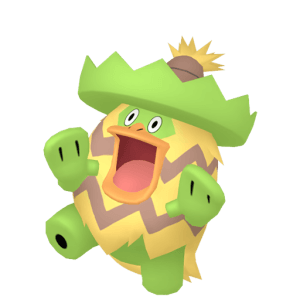In this recurring series, I’ll analyze the origins of Pokémon designs and their allusions to Mediterranean culture from Pokémon Scarlet and Pokémon Violet.
Quaxly

New trainers in the Paldea region can choose this Water-type Pokémon. Quaxly is the Duckling Pokémon. Its name fittingly is a combination of “quack”, “wax”, and “duckling”. The blue cap on its head is its hair, although it is preened to resemble something a sailor’s cap or the pompadour hairstyles amongst the royalty of Europe.
This Pokémon migrated to Paldea from distant lands long ago. The gel secreted by its feathers repels water and grime.
Its strong legs let it easily swim around in even fast-flowing rivers. It likes to keep things tidy and is prone to overthinking things.
Pokédex
Quaxly’s original region is unclear. During the height of Spain’s imperial power, its navy sailed around the world and touched many countries in the Mediterranean, South and Central America, and the Pacific. Ducks are common all around the world, though the crest of hair on its head makes it resemble the crested duck, indigenous to the western coast of South America. Crested ducks are also a domesticated breed of duck in Europe with a notable plume.
Quaxwell

Quaxly evolves into Quaxwell, whose head plume has now grown larger and more pompous. On its face, its duck bill has now morphed into something closer to a bird’s beak. The white feathers across its body have now been coated with dark and light blue accents, resembling something like a swimsuit. Quaxwell’s name is a combination of “quack”, “wax”, and “swell”.
These Pokémon constantly run through shallow waters to train their legs, then compete with each other to see which of them kicks most gracefully.
The hardworking Quaxwell observes people and Pokémon from various regions and incorporates their movements into its own dance routines.
Pokédex
Quaxwell is classified as the Practicing Pokemon, and we can tell its practice is in swimming. Ducks are naturally good as swimming, although Quaxwell goes further in turning swimming into an art form.
Artistic swimming is colloquially known as synchronized swimming, and was first developed in Germany at the end of the nineteenth century. It spread throughout Europe and abroad as a competition at the intersection of dance and water. Since 1984 it has been one of the sports in the Summer Olympics. Freestyle swimming is another Olympic sport where competitors can use any swimming style to compete for time.
Quaxwell’s dancing might relate more towards styles like flamenco, a musical genre that came out of the southern region of Spain in the nineteenth century. The dance component is called “Baile“, and is known for its expressive use of arms like Quaxwell’s pose. Baile dance has been referenced in the past, as it’s one of Oricorio’s forms.
Quaquaval

Quaxwell evolves into Quaquaval and gains the Fighting-type. Its tail feathers grow out into a brilliant train and its body grows more athletic. When it evolves, it learns the signature move Aqua Step which boosts its speed in addition to dealing damage. Its name is a combination of “quack”, “aqua”, and “carnival”.
A single kick from a Quaquaval can send a truck rolling. This Pokémon uses its powerful legs to perform striking dances from far-off lands.
Dancing in ways that evoke far-away places, this Pokémon mesmerizes all that see it. Flourishes of its decorative water feathers slice into its foes.
Pokédex
Quaquaval fully embodies its classification as the “Dancer Pokemon”. Its powerful legs are the envy of many other Pokemon. Tsareena’s Pokedex entry in Violet states that “It views Quaquaval as its rival.”
Quaquaval is based on peafowl, which are flightless birds from Southeast Asia. Early Christianity, which was the dominant religion of Spain, had a strong affection for peafowl. They were symbols of immortality due to the myth that its flesh did not decay. Many early church artworks included depictions of peafowl.
Carnival is a holiday that also has a strong tie to Christian and Spanish heritage. It takes place right before Lent and Ash Wednesday, a period of Christianity of fasting and moderation. This holiday is about celebrations and excess, encompassing Mardis Gras along with that Sunday and Monday.
The biggest festival held every year is in Rio de Janeiro, where performers dress up in elaborate costumes and dance on floats in a large parade. Brazil is far from Spain, but shares a lot of the same religious heritage after it was colonized by Portugal centuries ago. So Brazil might be the “far-off” land where it learned to dance.
The dance style might be based on samba, a style of dance that is prominent during Rio’s Carnival celebrations. It might also be capoeira, a form of Brazilian martial arts which combines fighting with dancing and acrobatic movements. Aqua Step would be the perfect intersection of dance with dealing damage for a Fighting-type Pokémon.
Conclusion
Spain’s influence in South America has been felt for centuries, and now this influence has inspired one of the first partner Pokemon of Paldea. Quaxly starts as a crested duck that lives in South American marshes, but it soon becomes motivated to grow stronger and learn to dance. It takes dance inspiration from Brazilian and Spanish styles and uses them to become even stronger as it reaches its final evolution.
This was my first partner Pokémon as I began my journey through Paldea and it became a reliable friend.
November Giveaway











